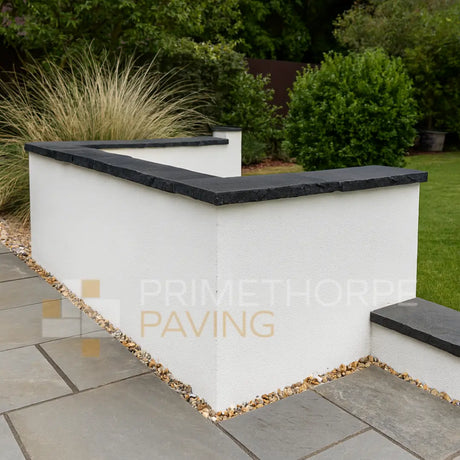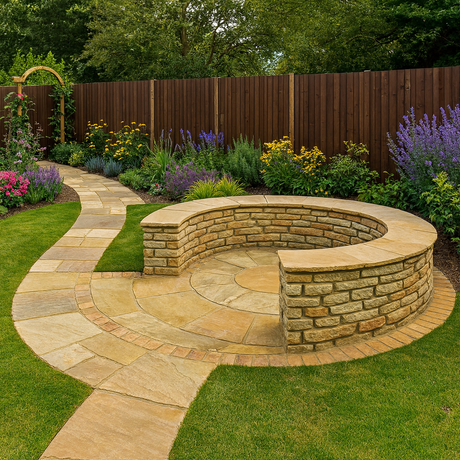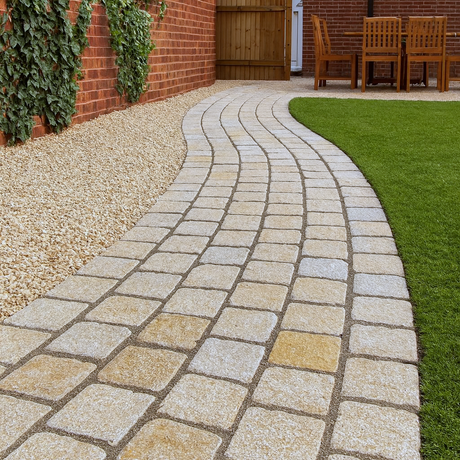It’s thought that around 87% of British homes have gardens, with this equating to around 23 million outdoor spaces nationwide.
We’ll explore some of the most pressing issues in the guide below, while asking how you can go about resolving them.
Butt Jointing and Failing to Leave Space Between Each Slab - Issue #1
Whenever you install paving slabs, you should always leave a space between each slab. This rule applies regardless of your chosen material, and failing to adhere to this can cause multiple problems.
For example, the lack of a sufficient gap between the edges can cause the slabs to impact against one another, as they continue to expand and contract continuously as the temperature continues to fluctuate.
Subsequently, the edging around the slabs will begin to fray and break up, with this commonly referred to in the industry as “shaling” or “spalling”.
This challenge is partially overcome through the use of a butt jointing technique, which connects two pieces of material simply by placing their ends together without any special shaping. In terms of space, your paving should be laid with a minimum 2mm gap between each slab, while it can subsequently be filled with a compatible jointing compound.
This should prevent your slabs from butting up against each other, minimising the risk of long-term wear and tear while making future alignment issues far less likely.

Weeds Growing In-Between Paving Slabs - Issue #2
Whenever you have paving in your front or back garden, weeds provide an almost constant issue that gardeners have to spend a disproportionate amount of their time attempting to resolve.
Not only do weeds grow continuously, for example, but they also pop up in the most inconvenient of places, preventing vital nutrients from reaching nearby plants and ruining the aesthetic of your garden space.
You’ll often find weeds shooting up in the gaps between your paving slabs, while the really bad news is that there’s nothing you can do to stop them from growing in the first place.
However, there are targeted products that you can use to help tackle weeds and keep them at bay, including chemicals and manual tools (such as an extending paving patio brush that extracts weeds physically from small and compact spaces) and even jointing compounds.
Jointing compounds probably provide the most effective and time-efficient solution as they refer to resin-based sand products that are applied to your paving and brushed into the gaps between slabs.
This sets solidly over a period of 24 hours, creating a firm joint and barrier between each slab that directly stops weeds from protruding.
For more information, read our guide on how to stop weeds growing between paving slabs, as you look to tame your garden’s weeds and create a more aesthetically pleasing space over time!

Stains & Dirt Marks On Patios & Paving - Issue #3
Over time, your paving is exposed to a number of natural elements and staining risks, especially if you like to entertain during the summer and regularly have guests in your garden.
These stains and marks can accumulate significantly over time, causing your paving to look tired and actually detracting from the aesthetics of your garden and (in the worst-case scenario) undermine the value of your home.
Perhaps the best way to avoid such issues is through regular cleaning and maintenance. To do this successfully, however, you’ll need to follow a step-by-step plan, which should start with clearing away any dust or debris before you start the actual cleaning process.
Then, you simply need to apply warm, soapy water to the surface, before using a stiff-bristled brush to scrub the stone. Just make sure that the water is pH neutral and doesn’t contain any acid, while the bristles shouldn’t be too stiff as this can cause the surface to be damaged (especially if you have smooth, natural paving).
Of course, specific rules and best practices will vary depending on the material from which your paving has been constructed, so check out our patio maintenance guide to learn more!

Staining Due to Algae On Your Patio - Issue #4
On a similar note, natural stones and concrete paving is also at risk of being heavily stained by the algae that grows in your garden space.
Algae growth is particularly prevalent on sandstone, with this material providing a hospitable host for various species of algae that are known to grow throughout the year. This risk is especially pronounced during the colder and winter months, with algae more likely to grow in damp and moist conditions.
So, it’s important to regularly clean your sandstone slabs and take care to remove any algae on a frequent basis.
You can do this by initially removing any heavy algae with a scraping tool, moving lightly and carefully to avoid scratching the stone. Then, use a pressure washer to lightly clean the surface and remove any loose debris, once again utilising warm and soapy water rather than a chemical agent.
Once the surface has dried, you can re-clean it using a light bleach mixture if the paving is heavily stained with algae.
This is an optional step, however, and the mixture that you use should only ever comprise 30% or 40% bleach and warm water.

Void Bedding Your Paving Slabs - Issue #5
Regardless of your chosen material, all paving slabs must be laid on a full bed of mortar in order for them to benefit from a secure foundation.
There are no exceptions to this rule, but despite this some people continue to install paving slabs in a way that leaves gaps underneath and ensure that they’re not fully supported. This is referred to commonly as ‘void bedding’, and can cause a number of potential issues over time.
For example, void bedding can cause the mortar to draw water from flooded spaces beneath the paving up into the slabs. This can cause deep staining, which is hard to remove successfully over time.
Even more worryingly, the voids can fill with water over time and cause potential subsidence and instability, causing the paving to crack and become unsafe in the process.
The good news is that this is solely an installation fault, and can be either corrected or avoided at source simply by laying slabs directly onto a full bed and foundation of mortar.

Inadequate Drainage On Your Patio - Issue #6
After heavy or sustained periods of rain, have you ever noticed that large surface puddles remain in place for a few days?
If so, you may have drainage issues that run throughout the garden space. This can be initially caused by a broad range of factors, from having a garden that sits below the water table to a significantly uneven surface.
Having a flat surface is certainly key if you’re to lay paving slabs successfully, especially if you’re to avoid the serious risk of misalignment or cracking over time. Similarly, an even surface could cause surface water to settle in areas of your paving, creating damp issues and deep staining.
Ultimately, the key is to determine the precise draining issues that exist in your garden, before creating a viable plan of action to correct these and ensuring that the level in your outdoor space is as even as possible.

DIY Installation of Paving Slabs - Issue #7
If you’re attempting a DIY paving installation, the risk of laying slabs incorrectly or failing to align them properly is significant.
Rushing can also contribute to significant issues, and there’s a few things to keep in mind before starting the project.
For example, you should focus on avoiding so-called cross joints and ensure that all connections are as even as possible. This minimises the risk of misalignment or cracking, which can undermine even the most durable and highest grade materials.
From a visual perspective, try to make sure that all natural stone slabs are laid with the finished surface visible to the naked eye. At this stage, you can confidently start to point and seal the edging, contributing to a secure and aesthetically pleasing installation in the process.
For more information, discover our laying paving slabs guide, including tips on laying the sub-base and guaranteeing the best possible installation.

Shaling and Delamination of Your Paving Slabs - Issue #8
You may not have heard of the word ‘shaling’, which is often used interchangeably with delamination and describes a process where a material begins to fracture into layers.
This can affect the riven surfaces of some sedimentary paving materials like sandstone and limestone, which may start to break away in small segments after a period of significant footfall, impact damage or aggressive cleaning (including the use of high pressure jet washing).
Interestingly, this is rarely an issue with the slab itself, nor is it indicative of any issues that exist beneath the surface. In fact, the foundation and sub-base can remain stable while delamination occurs, even if this happens a good while after installation.
Clearly, you can avoid this issue largely by cleaning your paving with care, washing it at a low pressure while avoiding the use of harsh chemical agents.

Paving With Tripping Hazards - Issue #9
We’ve already touched on the issues posed by uneven surfaces and poor installation, but such problems can also create significant tripping hazards outdoors.
Often, this issue is also due to a problem with the construction of the base, whether the ground was not compact enough to bear the weight of the slabs at the time of installation or the sub-base too thin at the time of installation (it should have a minimum thickness of 75mm).
So, paying careful attention to the construction of the base and ensuring the surface is as even as possible is crucial if you’re to avoid the formation of tripping hazards.
Tripping hazards can also occur when uneven gaps develop between the slabs. This is why you need to take time with the installation and ensure that each joint is even (with a minimum of 10mm space left between each slab), while paying regular attention to your paving to make sure that it doesn’t become fragmented or damaged over time.
Similarly, try to avoid leaving too much extra space between slabs, which is often an unfortunate consequence of ensuring that slab edges don’t butt against one another.

Sunken Paving - Issue #10
Let’s get real; sunken paving not only represents an eyesore, but as we’ve already touched on, it may also be indicative of a much larger issue.
If you do have sunken paving, this could be the sign of a drainage issue that predated installation. It may also suggest that the sub-base was prepared or laid or incorrectly, which means that the paving will need to be removed for this issue to be corrected.
From the latter perspective, preparing a base requires adequate excavation, to a depth that’s determined by numerous factors like existing drainage and soil type. If you fail to excavate deep enough, you’re likely to see sunken paving occur at some point in the near future.
To avoid or correct the issue of sunken paving, it’s also important to ensure that the underlying surface is as even, compact and stable as possible at the point of installation.
This even means removing loose soil or any debris that has been left during the excavation, as even the smallest details can have a big impact on the stability of your paving.

The Bottom Line
So, there you have it, our comprehensive guide to paving problems and how they can be resolved!
By following this guide, you can correct any issues as they occur, while hopefully ensuring that any future installations are completely stress and hassle-free!






